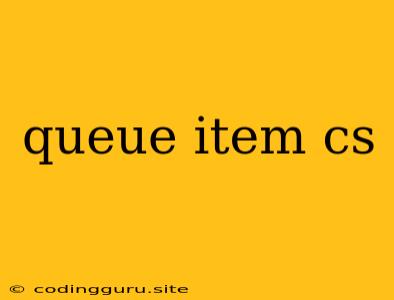Understanding Queue Items in Customer Service: A Comprehensive Guide
In the bustling world of customer service, managing inquiries and requests efficiently is paramount. Queue items, a fundamental concept in customer service systems, play a crucial role in this process. Let's delve into the intricacies of queue items and explore how they streamline customer service operations.
What Are Queue Items?
Imagine a virtual waiting room where customer interactions are lined up. Each entry in this waiting room is a queue item. It represents a specific customer interaction, whether it's a phone call, email, chat message, or social media inquiry.
Queue items encapsulate critical information:
- Customer details: Identifying information like name, email address, phone number, etc.
- Type of request: What the customer needs help with, such as product inquiries, technical support, or billing issues.
- Priority level: A system for categorizing urgent or important requests, ensuring timely resolution.
- Status: The current state of the interaction, like "Open," "In Progress," or "Resolved."
- Assigned agent: The customer service representative responsible for handling the request.
- Timestamp: The date and time the request was received.
The Role of Queue Items in Customer Service:
Queue items form the backbone of efficient customer service workflows. They provide a structured way to manage customer interactions, allowing agents to:
- Prioritize requests: Agents can quickly identify high-priority requests and address them promptly.
- Track progress: Easily monitor the progress of each interaction, ensuring no request falls through the cracks.
- Allocate resources: Distribute work effectively among available agents, optimizing service efficiency.
- Improve customer satisfaction: By ensuring timely and accurate responses, queue items contribute to positive customer experiences.
Benefits of Utilizing Queue Items:
Integrating queue items into your customer service strategy offers several benefits:
- Increased efficiency: Reduces the time it takes to process requests, allowing agents to handle more inquiries.
- Improved transparency: Customers can track the status of their requests, fostering trust and communication.
- Better data analysis: Detailed information about queue items provides insights into customer behavior and service patterns.
- Enhanced team collaboration: Facilitates seamless collaboration between agents and supervisors.
Managing Queue Items Effectively:
To maximize the value of queue items, follow these best practices:
- Clearly define queue item attributes: Ensure all essential information is captured to enable accurate tracking and analysis.
- Establish a robust prioritization system: Categorize requests based on urgency and importance to ensure prompt attention to critical issues.
- Implement a user-friendly interface: Agents should be able to easily navigate and manage queue items.
- Utilize automation: Automate tasks like status updates and notifications to free up agents for more complex interactions.
- Monitor queue performance: Regularly track key metrics like average wait time and resolution rate to identify areas for improvement.
Example: Implementing a Queue Item System:
Let's consider a customer service department for a software company. They might use a system where a new customer support request creates a queue item with the following details:
- Customer Name: John Doe
- Email: [email protected]
- Request Type: Technical Support
- Issue: Unable to access the software
- Priority: High (due to immediate impact on the customer)
- Status: Open
- Assigned Agent: Agent Smith
Once Agent Smith begins working on the request, the status changes to "In Progress." When the issue is resolved, the status becomes "Resolved." This entire process is documented through the queue item, providing a comprehensive history of the interaction.
Conclusion:
Queue items are a fundamental element of modern customer service systems. By effectively managing and leveraging queue items, organizations can enhance customer service efficiency, improve customer satisfaction, and gain valuable insights into their operations. Embracing queue items as a strategic tool empowers businesses to provide exceptional customer experiences in today's competitive landscape.
